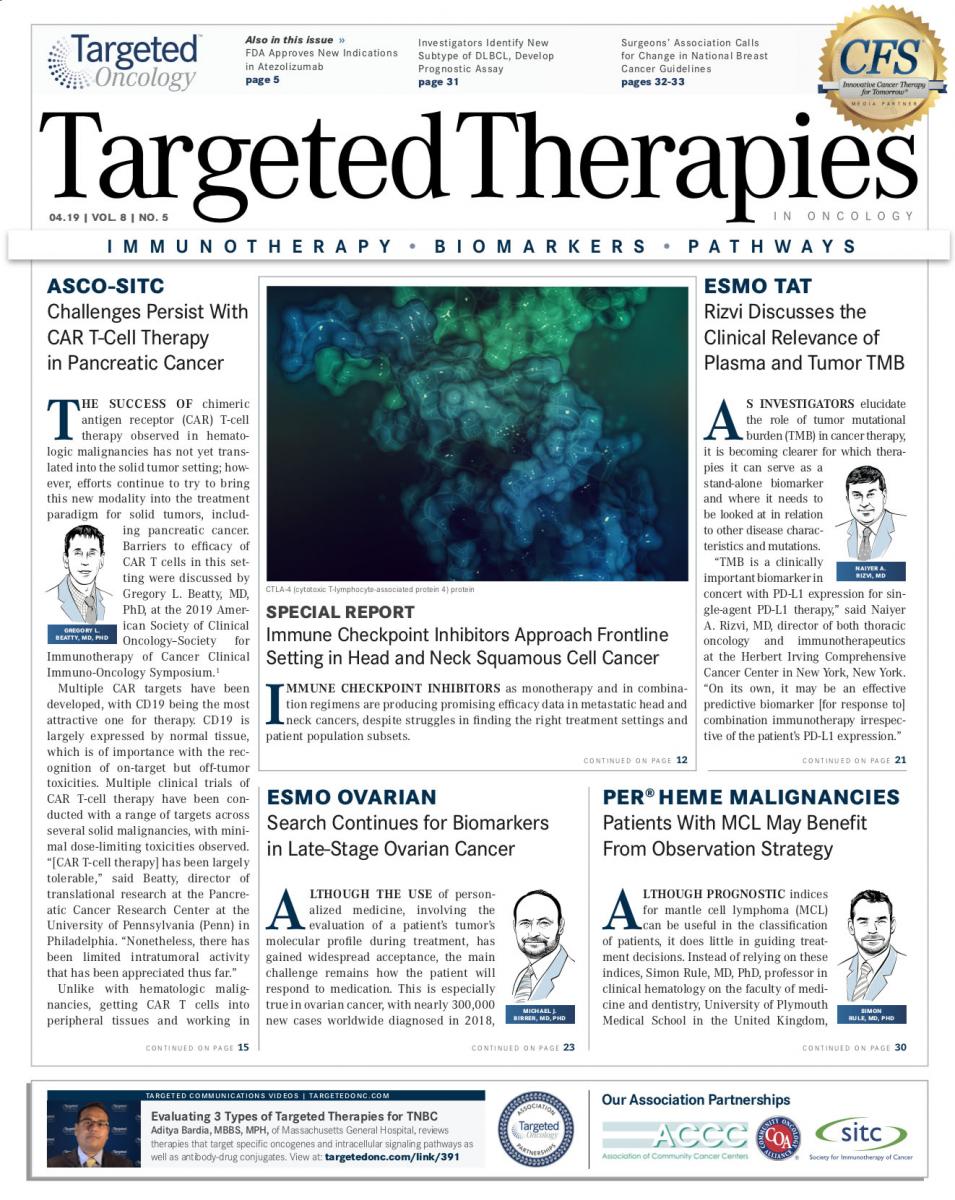Rizvi Discusses the Clinical Relevance of Plasma and Tumor TMB
Naiyer A. Rizvi, MD, explained, in a presentation at the European Society of Medical Oncology 2019 International Congress on Targeted Anticancer Therapies, that plasma assays for determining TMB are becoming more diagnostically relevant.
Naiyer A. Rizvi, MD
As investigators elucidate the role of tumor mutational burden (TMB) in cancer therapy, it is becoming clearer for which therapies it can serve as a stand-alone biomarker and where it needs to be looked at in relation to other disease characteristics and mutations.
“TMB is a clinically important biomarker in concert with PD-L1 expression for single-agent PD-L1 therapy,” said Naiyer A. Rizvi, MD, director of both thoracic oncology and immunotherapeutics at the Herbert Irving Comprehensive Cancer Center in New York, New York. “On its own, it may be an effective predictive biomarker [for response to] combination immunotherapy irrespective of the patient’s PD-L1 expression.”
Rizvi explained, in a presentation at the European Society of Medical Oncology 2019 International Congress on Targeted Anticancer Therapies, that plasma assays for determining TMB are becoming more diagnostically relevant.
What is important now is figuring out the respective values for determining high levels of TMB in each tumor type. An analysis into the association between overall survival (OS) after treatment with immune checkpoint inhibitor therapy, which included combination or monotherapy with CTLA-4 or PD-1/L1 inhibitors, and nonsynonymous somatic TMB was assessed using the MSK-IMPACT assay in 1662 patients across multiple tumor types.1Those patients within the top 20% of TMB expression for their tumor type were observed to have better rates of OS as a result of treatment, and investigators said that the data are most likely indicative of a benefit across all cancer types. Interestingly, the cutoff value for high TMB varied widely between disease types.
Rizvi also pointed out that it is important to consider that different commercial panels may yield varying results and that most platforms require a certain number of mutations to produce an accurate assessment for TMB.
He went on to compare whole-exome sequencing (WES), the gold standard of genomic profiling, with the FoundationOne CDx and the MSK-IMPACT next-generation sequencingbased assays. He said that although these panels are fairly accurate, the comparison is not 1:1 with WES and there is a lack of standardization for TMB calculations between these tests.
Utility of TMB as a Biomarker
Rizvi pointed out that TMB expression does not seem to correlate with the magnitude of PD-L1 expression or immune infiltration in all patients. However, when both high TMB and PD-L1 expression are observed, patients are considered more likely to benefit from immunotherapy.
In the phase III CheckMate 227 trial of nivolumab (Opdivo) in combination with ipilimumab (Yervoy) in patients with stage IV or recurrent nonsmall cell lung cancer (NSCLC) not previously treated with chemotherapy, progression-free survival (PFS) was assessed in patients with TMB ≥10 mutations per megabase.2The findings showed that although TMB was predictive of response in patients treated with the combination immunotherapy regimen, PD-L1 expression and TMB were mutually exclusive and there was no apparent correlation between the 2 biomarkers.
In the negative phase III trial, IMvigor211, which compared atezolizumab (Tecentriq) with chemotherapy, patients with metastatic urothelial carcinoma after disease progression on platinum-based chemotherapy with high TMB saw an OS benefit with atezolizumab over chemotherapy (HR, 0.68).3When investigators looked at patients with both high TMB and PD-L1 expression ≥5%, the OS improved further and the hazard ratio was even more favorable, at 0.50. These results indicate that, for single-agent PD-1 inhibitors, TMB is probably not sufficient as a stand-alone biomarker, Rizvi said.
TMB in Plasma Offers Advantages in Heterogeneity
The ability to test TMB in plasma offers an advantage over obtaining invasive tumor samples that present difficulties for many patients, Rizvi said. An analysis of the POPLAR and OAK trials of atezolizumab in patients undergoing second-line or higher treatment for NSCLC showed that blood TMB (bTMB) was evaluable in about 75% of patients and was an actionable biomarker for predicting PFS in this subset of patients.4
“What is not clear is that when you look at the OS data, there does not seem to be that much of a difference [in patients] with high or low TMB,” Rizvi said.
Another interesting finding from the analysis was that for patients who had both tumor and plasma evaluable for TMB, the shared variance was observed in 59%. For the remaining patients, TMB was present in either the tumor or blood only. Rizvi said this concordance is not optimal.
However, when investigators further looked at circulating tumor DNA samples that they ran on both plasma and tumor panels, they found that concordance was good. He said this indicated that what is observed in TMB collected in tumor samples (tTMB) is just different from what is seen in the plasma.
“[One] possible conclusion is that the plasma is just more representative of tumor heterogeneity, and perhaps this could be a better assay than from tumor [samples].”
In the phase III MYSTIC study, which looked into the frontline combination of durvalumab (Imfinzi) and tremelimumab versus durvalumab alone or platinum-based chemotherapy in patients with stage IV NSCLC, TMB was evaluated using the GuardantOMNI assay in plasma and FoundationOne CDx in tumor samples.5The overall correlation for tTMB versus bTMB was 0.6.
“Again, we are seeing a similar phenomenon as far as the concordance not being perfect,” Rizvi said. “In my mind, I think this does reflect the heterogeneity in what is shed [by the tumor] versus [a] single biopsy site.”
He did point out that ≥10 mutations per megabase in tTMB was correlative with bTMB ≥16 mutations per megabase in the MYSTIC analysis.

Powell Reviews Updated IO/TKI Data and AE Management in Endometrial Cancer
April 18th 2024During a Case-Based Roundtable® event, Matthew A. Powell, MD, discussed the case of a patient with advanced endometrial cancer treated with lenvatinib plus pembrolizumab who experienced grade 2 treatment-related hypertension.
Read More